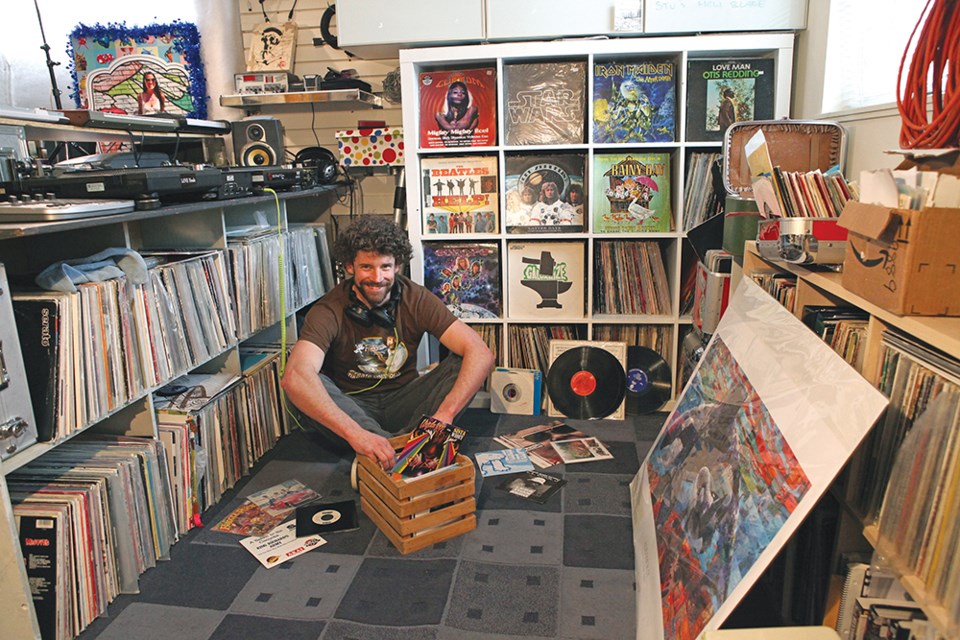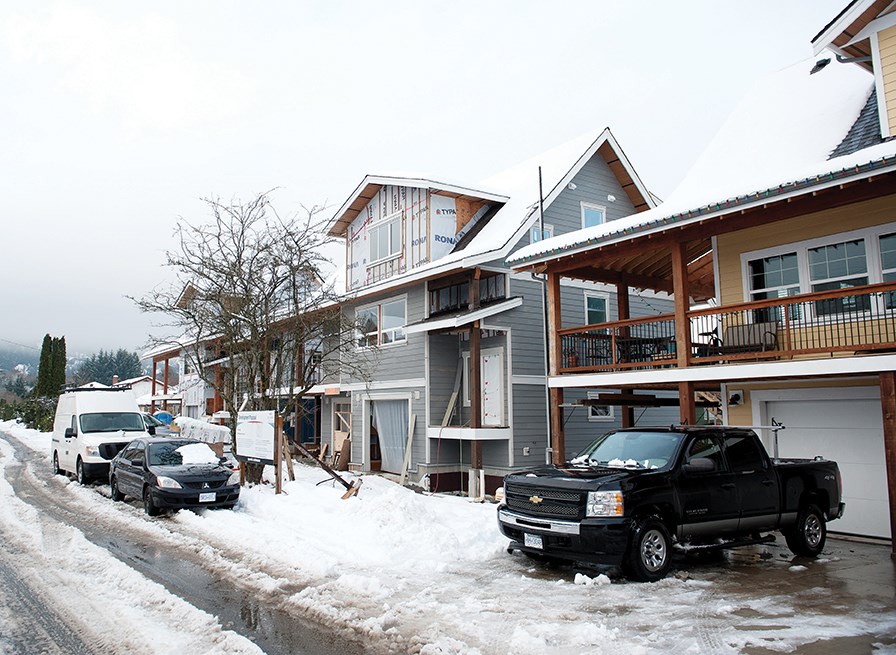No matter how you look at it, 2016 was a banner year for Squamish. The Squamish Chief whittled down the year that was into the top events based on their impact on the community or the level of buzz they created.
Housing crunch
Nothing has been more discussed in the District of Squamish this year than housing. Both the increasing cost of housing and the pace of development have been off the charts in 2016.
In the last year in Squamish, the overall cost of housing has gone up 26 per cent, according to The Real Estate Board of Greater Vancouver. The benchmark price of a single-family home sits at $792,100, while a townhouse is $628,000, the largest increase over last year at about 30 per cent. Apartments cost about $361,200 as of November.
“Anytime you have a successful community… you are going to create demand cycles that supply cycles just don’t meet. I wish we could control that more because our intentions are good in terms of affordable housing,” said Mayor Patricia Heintzman. “But the developers do control the tap – they can turn it on or turn it off.”
On the development side, 2016 saw 16 development permits issued for a total of 540 new residential units and 7,380-square-metres of combined commercial and industrial space, according to district staff.
Eleven development permit applications still remain in stream that were applied for in 2016. In addition, 110 single-family lots were subdivided this year and 143 such lots are currently in stream for subdivision.
About 5,000 units are on the horizon to be built in Squamish, Heintzman said.
“What the district has figured out, is that we need to be very strategic and more determined about getting purpose-built rentals – encouraging the smaller guys and the homeowners to help create affordable housing, whether it is through suites or laneway housing, that kind of thing,” she said.
The District of Squamish housing task force published its Affordable Housing Strategy in 2016 and Heintzman said hiring a housing coordinator in 2017 could be the impetus for further housing relief.
“Housing has always been something that has been done off the side of the desk... but if council determines we will hire a housing coordinator, someone who is focused on those social planning issues, housing being number one, then I think you are going to see a lot of movement on that front.”
Power of the Squamish Nation
The Squamish Nation has increasingly taken its rightful place in the sun in the Lower Mainland and that influence reached Squamish in 2016.
“For the Squamish Nation, 2016 was a dramatic and eventful year,” said Chief Ian Campbell.
“Many important decisions were made by the Squamish Nation, a major voice in this town, this region, this province. And all reflect the interests, the will and the beliefs of our members.”
Most notably, March’s federal approval of the Woodfibre LNG proposal came after a lengthy process of intense negotiation based on the Nation’s independent environmental assessment.
In October, the Nation pressed Woodfibre to change from a seawater-cooling system to an air-cooled one, “thus protecting valuable fish stocks and sensitive marine habitat in the estuary and in Howe Sound,” Campbell said.
But the deal has yet to be finalized. That may come in 2017, according to the Nation. “Conditions must still be met. Important work is yet to be done,” Campbell said.
On the national stage, the Squamish Nation condemned and rejected Kinder Morgan’s proposed expanded oil pipeline and tanker traffic, “which will almost certainly bring the increased risk of an oil spill with the potential to destroy marine environments,” Campbell added.
The Nation has joined forces with other First Nations to fight the National Energy Board’s Kinder Morgan approval in court.
Locally, the Squamish Nation is involved in various projects from business ventures such as the Newport Beach development and the potential Cheekye Fan housing community, as well as in a partnership with the district for a potential community forest.
Mayor Patricia Heintzman noted that, while the District of Squamish is on unceded Squamish Nation territory, the Nation is also one of the top landowners in the Sea to Sky Corridor.
“I think it was inevitable and the right direction that Squamish Nation starts to play a big role in driving the vision in the entire corridor,” she said. “I welcome it... there’s so much we gain from having a vibrant, strong Squamish Nation in the valley and particularly in Squamish. ”
Woodfibre LNG approved
It was a big year for Woodfibre LNG, slated for about six kilometres south of downtown Squamish on the shores of Howe Sound, and its associated FortisBC pipeline.
In March the Woodfibre LNG proposal received its environmental approval from the federal government.
In June, Squamish Nation chiefs and council voted to approve an Environmental Assessment Agreement for the proposed Eagle Mountain-Woodfibre Gas Pipeline Project and issued an environmental certificate.
The company’s long-anticipated final investment decision came on Nov. 4, when it was announced Woodfibre’s parent company, Pacific Oil & Gas Limited that is part of the Singapore-based RGE group of companies, had authorized the funds necessary for the liquified natural gas project to proceed.
While it was all pomp and ceremony for the announcement, which was replete with Premier Christy Clark flying in by helicopter to the Woodfibre LNG site and a bevy of media boated in, the cloud of arson at the downtown Squamish Woodfibre and Fortis community office the day before, the lack of Squamish Nation leadership representation at the event and continued opposition from My Sea to Sky and some Nation members with Skwomesh Action cast a shadow over the celebration.
The Woodfibre and Fortis community office has moved to a temporary location while repairs are completed on the scorched downtown office. The renovated office should reopen in about three months, according to Woodfibre officials.
The FortisBC’s Eagle Mountain-Woodfibre Gas Pipeline Project received provincial environmental approval in August, but Squamish Nation leadership is continuing talks with the province, according to a Nation spokesperson.
Several permitting milestones for the liquefied natural gas export facility should be reached in 2017, according to Byng Giraud, Woodfibre LNG’s vice president of corporate affairs.
“Less of the ‘yes or nos’ and more of the ‘hows,’” Giraud said.
The company has to apply to amend the provincial environmental assessment to account for the Squamish Nation choosing air-cooling over water-cooling for the facility.
BC Oil and Gas Commission certificates, minor scale permits from the District of Squamish – a demolition permit and development permit – and management plans with First Nations have to be in place before construction, Giraud added.
“We’ll begin some early work on the site, part of the remediation and disassembly of what is there already,” he said.
The company is still aiming for actual construction to get underway in 2017, but that is permit dependant, he said. The two shortlisted front-end engineering design firms should be submitting their bids by summer.
“Once we select one of those, assuming the permits are all in place, construction starts,” Giraud said.
As things ramp up for the company in 2017, the opposition groups are sure to continue their fight as well.
In November, about 300 people gathered to express continued opposition to the project at a rally organized by My Sea to Sky and Skwomesh Action.
My Sea to Sky has vowed to make the Woodfibre LNG facility and protection of Howe Sound a provincial election issue this spring.
A group of Valleycliffe citizens will likely continue to voice their concerns as well over the FortisBC compressor station slated for near their neighbourhood.
Garibaldi at Squamish
Decades after the idea of a ski resort on Brohm Ridge was first floated, the revamped $3.5-billion Garibaldi at Squamish all-season resort – now backed by Canadian heavy-hitters Aquilini Group and Northland Properties – received provincial approval on Jan. 29.
Though the development, which would include ski lifts, biking trails, hotels and private residences, received conditional support of the Squamish Nation, it continues to be contentious for many in the Sea to Sky Corridor. The District of Squamish, the Squamish-Lillooet Regional District, Village of Pemberton and the Resort Municipality of Whistler have all expressed concern about the proposal.
Local concerns have ranged from its economic viability to increased traffic to its impact on the environment.
President of Garibaldi at Squamish Jim Chu says the team behind it will ramp up public engagement in the coming year.
“We look forward to getting public input by presenting updated visions and draft concept plans to the community and local governments in a consultative manner before proceeding with any development applications,” Chu told The Squamish Chief. The project “will create thousands of new jobs, economic benefits for local businesses, new tax revenues for governments and be a world-class natural mountain ‘playground’ for locals and tourists to enjoy.”
Funk’s fight for citizenship
In April, Byrdie Funk, a Squamish counsellor, discovered that even though she had lived almost her entire life in Canada, she was no longer a citizen due to an obscure section in the 1977 citizenship act, Section 8, which applies to people born between Feb. 15, 1977 and April 16, 1981.
Those citizens must apply to retain their citizenship before they turn 28, or lose it. Because she was brought to Canada from Mexico when she was two-months-old Funk had no idea she was supposed to apply.
After she went public with her story this summer she found the community of so-called Lost Canadians across the nation who also are without citizenship due to cracks in the Canadian Citizenship Act.
Her fight joined theirs and she spent the year speaking out and gathering allies in Member of Parliament and Critic for Immigration, Refugees and Citizenship Jenny Kwan and, ultimately, support from Sea to Sky Member of Parliament Pamela Goldsmith-Jones.
In December, Kwan flew Funk to Ottawa where Kwan tabled a private member’s bill in the House of Commons – Bill C-333 to amend the Citizenship Act. First reading was Dec. 14. If the federal government ultimately adopts the bill, it will cover people like Funk, as well as those who are second-generation Canadians born abroad and refugees who returned to their country of origin to visit and lost their citizenship, according to Funk.
The year of advocating for herself and others has given Funk a unique perspective on seeking justice from government.
“It is really difficult to get through to the government, it is so hard,” she said. Persistence is key, she said.
Funk added that the community of Lost Canadians, led by Don Chapman, has been the biggest support to her and without them she wouldn’t likely be looking ahead to future readings of the bill that could restore her and others’ citizenship. “I think if there is something you are passionate about or you are suffering an injustice, try and find a group that is already doing the work. Don’t try and do it by yourself,” she said.

Squamish honours The Hip
For nearly three hours on one summer evening, a wave of emotion swept through Squamish as thousands gathered to watch frontman Gord Downie clutch the microphone and belt out his last performance with The Tragically Hip.
Known for hits such as New Orleans is Sinking and Wheat Kings, the group from Kingston, Ont., has commanded a devoted following since its start in 1983.
And on Aug. 20, that following – now 11.7 million-strong – glued their eyes to their TVs, tuned in their radios and hunched over their computers to bid Downie and the rest of the band a fond farewell.
Squamish was no exception, as the community huddled around a giant screen in the downtown core near the municipal hall to watch The Hip play a 30-song set, with three encore performances.
It was an occasion that carried a lot of baggage, as the group had recently revealed Downie had been diagnosed with an incurable brain cancer known as glioblastoma.
Squamish residents took that as a cue to pay it forward – the Canadian Cancer Society raised about $4,450 at the event.
The Chief’s Steven Hill was right in the thick of it, wandering the town’s streets, talking to many in the audience who had a story to share about their encounters with the band.
Many talked about their first time seeing the group, and about how The Hip changed their lives through the power of their music.
As always, Downie sang his heart out and guitar duo Paul Langlois and Rob Baker filled the air with slick melodies, which spiraled over the toe-tapping groove of bassist Gord Sinclair and drummer Johnny Fay.
Downie also used the time to make an impassioned plea to Prime Minister Justin Trudeau, who was in attendance at the live show in Kingston, to improve relations with Canada’s indigenous peoples.
The frontman was also recently honoured by the Assembly of First Nations for his advocacy work revealing the impact of residential schools.
Downie’s most recent project was a documentary following a 12-year-old who died in 1966 trying to escape from a residential school in Ontario.
And while The Hip may have played their last live show, Downie has hinted the group has been working on a new record.
Squamish Valley Music Fest leaves
While Squamish was forced to bid an unexpected farewell to one music festival this year, it may have an opportunity to welcome another.
In March, the organizers of the annual Squamish Valley Music Festival announced the event was cancelled.
It was an unexpected blow to many regular concertgoers who had flocked to town to see A-list music acts such as Bruno Mars, Eminem, Arcade Fire and Drake.
No reason was given for the cancellation, and repeated queries from The Chief were not returned by Brandlive, one of the companies responsible for organizing the festival.
But there may be an event willing to fill a Squamish Valley Music Festival-sized hole in town.
After hearing about the cancellation of the event, organizers from a festival called the World of Music, Arts and Dance (WOMAD) expressed interest in setting up concerts of their own starting in September 2017.
However, there are some notable differences between this proposed festival and the one it could be replacing.
In terms of size and scale, WOMAD is a smaller event estimated to bring in about 60,000 attendees, which is about half as many as the outgoing Squamish Valley Music Festival.
Revenue from WOMAD would be about $4 million, while its predecessor brought in about $32 million every year.
The types of artists will also be markedly different.
Instead of showcasing A-listers, WOMAD intends to focus on family-friendly music that brings different cultures together.
For example, Siberian throat singers could be sharing the stage with Japanese lute players.
Sponsorship would also see some changes.
Organizers said they would emphasize collaborating with local businesses – they have no intention of working with major brands. They also intend to get Quest University involved in the event.
WOMAD festivals typically have multiple stages, musical and dance acts, workshops and a global food village.
Earlier this year, Mayor Patricia Heintzman expressed enthusiasm for the event, saying it would fit in with the town very well.
But no contracts have been inked as of now – negotiations are still ongoing.
“The District remains in contact with WOMAD Canada, and understands Squamish to be the preferred location for their Canadian launch,” the district wrote in an emailed statement to The Chief last week. “We are awaiting concrete next steps to be provided by the producer that would outline a timeline to work towards an inaugural event.”
Loss of a beloved artist
Upon news of his death, the flickering candlelight of a makeshift memorial illuminated the mural Chili Thom painted for the Squamish Wind Festival in downtown.
The painting features vividly-coloured salmon racing through strands of kelp and was just one example of how the much-loved artist left his mark on the community.
Thom, who was renowned for his collaborations on projects such as the 2013 downtown banners, as well as his involvement with the Squamish Arts Council, lost his battle against cancer on Nov. 30.
The loss of Thom left many in the community distraught, and artists from around town paid homage to his influence on their craft as well as their lives.
Thom was remembered as an energetic man who was full of charisma and community spirit.
Mayor Patricia Heintzman commended Thom for his influence on the town, saying he left a mark in Squamish’s artistic community that was “perhaps unsurpassed.”
The painter’s peers were quick to share how his positive character affected their lives.
Mural artist Stan Matwychuk called Thom “a giant” in the town’s art scene.
Brackendale Art Gallery’s Thor Froslev expressed admiration for Thom’s work and sculptor Christina Nick said that his work would carry on his memory.
Thom’s love for the outdoors was very apparent in the paintings he created. One piece features a moonlit forest capped with snow, while another transports the viewers up in the air to watch a crimson sun ignite a bed of clouds.
Perhaps one of his most impressive pieces takes the audience underneath a giant wave, where they can watch water form a shimmering tunnel towards the horizon.
Thom’s loss was made even more bitter because of his young age – he was only 40 when he passed, leaving some to speculate on the work he would’ve created had he been around longer.
He spent 20 years of his life in the Sea to Sky Corridor before moving to Billings, Mont. in order to receive specialized medical treatments not available in Canada.




